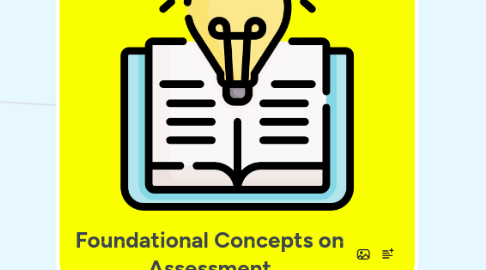
1. Assessment Challenges and Consequences of Pre-and Post Pandemic Times
1.1. Pre-Pandemic Times
1.1.1. Assessments measure low-level thinking skills only
1.1.2. Gender and cultural sensitivity of test items
1.1.3. Assessment too focused on the cognitive domains only
1.1.4. Activities and assessments too difficult for learner's level of understanding
1.2. Post Pandemic Times
1.2.1. Difficulty in feedbacking
1.2.2. Cheating and plagiarism
1.2.3. Ways to conduct psychomotor and affective assessments
1.2.4. Activity requires materials not accessible to learner's home
1.2.5. Difficulty in monitoring student progress
2. Philosophy and Nature of Assessment
2.1. Philosophy of Assessment
2.1.1. Effective Teaching and Learning Process
2.1.2. Allow teachers and learners to evaluate teaching and learning strategies
2.1.3. Continuous monitoring of learner progress and achievement
2.1.4. Promotes learner-centered environment
2.1.5. Aligned with the learning competencies and lesson objectives
2.2. Nature of Assessment
2.2.1. Reliable
2.2.2. Fair
2.2.3. Practical and efficient
2.2.4. Continuous
2.2.5. Authentic
2.2.6. Ethical
2.2.7. Good communication
2.2.8. Has positive consequences
3. The SAIL Cycle (Science Assessment Instruction Cycle)
3.1. Engage
3.1.1. Active participation
3.1.2. Motivation
3.1.3. Prior knowledge
3.2. Explore
3.2.1. Main activity
3.2.2. Address the psychomotor objective
3.2.3. Answers what should learners do to achieve the cognitive objective
3.3. Elaborate
3.3.1. Practical application
3.3.2. What should learners do now that they learn the topic
3.4. Evaluate
3.4.1. Used to check the misconceptios
3.4.2. Summative assessment
3.4.3. Measures learner's achievement of the objectives
3.5. Explore
3.5.1. Main activity
3.5.2. Address the psychomotor objective
3.5.3. Answers what should learners do to achieve the cognitive objective
4. Forms and Kinds of Assessment
4.1. Modes
4.1.1. Traditional Assessment
4.1.1.1. Pen-and-Paper Tests
4.1.1.1.1. Scoring Manner
4.1.2. Performance-Based Assessment(PBA)
4.1.2.1. Rubrics
4.1.2.1.1. Holistic
4.1.2.1.2. Analytic
4.1.2.1.3. Ana-Holistic
4.1.2.2. Criteria for Good PBA
4.1.2.2.1. Generalizability
4.1.2.2.2. Authenticity
4.1.2.2.3. Multiple Foci
4.1.2.2.4. Teachability
4.1.2.2.5. Feasibility
4.1.3. Portfolio Assessment
4.1.3.1. Working Portfolio
4.1.3.2. Show Portfolio
4.1.3.3. Documentary Portfolio
4.1.4. Affective Assessment
4.1.4.1. Attitude Scales
4.1.4.1.1. Rating Scales
4.1.4.1.2. Semantic Differential Scale
4.1.4.1.3. Likert Scale
4.1.4.2. Personality Assessments
4.1.4.2.1. Non-projective Tests
4.1.4.2.2. Projective Tests
4.1.4.2.3. Checklists
4.2. Purposes
4.2.1. Assessment for Learning
4.2.1.1. Placement evaluation
4.2.1.2. Diagnostic evaluation
4.2.1.3. Formative evaluation
4.2.1.4. Done before and during the teaching process
4.2.2. Assessment of Learning
4.2.2.1. Summative assessment
4.2.2.2. Done at end of a unit, lesson, or course
4.2.3. Assessment as Learning
4.2.3.1. Metacognition for learners
4.2.3.2. Assessment evidences for self-reflection of learners
4.2.3.3. Includes peer and self-assessments
4.2.3.4. Done during the teaching process
5. Writing Measurable Learning Objectives
5.1. ABCD approach
5.1.1. Audience
5.1.1.1. Learners
5.1.2. Behavior
5.1.2.1. Target knowledge, skill, or attitude to achieve.
5.1.3. Condition
5.1.3.1. Specific situations
5.1.4. Degree
5.1.4.1. Frequency or number
5.2. Identify the domain
5.2.1. Cognitive
5.2.1.1. Knowledge
5.2.2. Psychomotor
5.2.2.1. Skills
5.2.3. Affective
5.2.3.1. Attitudes
5.3. Characteristics
5.3.1. Must be SMART
5.3.1.1. Specific
5.3.1.2. Measurable
5.3.1.3. Attainable
5.3.1.4. Relevant
5.3.1.5. Time-bound
5.3.2. Aligned to the intended outcomes
5.3.3. Clear and concise
5.4. Bloom's Taxonomy
5.4.1. Lower Order Thinking Skills
5.4.1.1. Remembering
5.4.1.1.1. Recall information or facts.
5.4.1.2. Understanding
5.4.1.2.1. Grasp the meaning of information.
5.4.2. Higher Order Thinking Skills
5.4.2.1. Applying
5.4.2.1.1. Use information to new but similar situation.
5.4.2.2. Analyzing
5.4.2.2.1. Break a bigger picture into parts and identify the relationships between them.
5.4.2.3. Evaluating
5.4.2.3.1. Examine the information and make judgements.
5.4.2.4. Synthesizing
5.4.2.4.1. Use the information to create something new.
